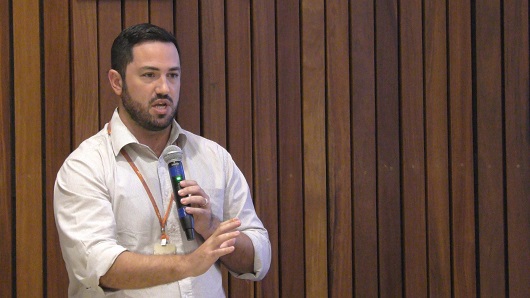Fiocruz researcher is part of the WHO group for neglected diseases
31/01/2022
Cristina Azevedo (Fiocruz News Agency)
When a new advisory group of the World Health Organization (WHO) for neglected diseases holds its first meeting this Friday, January 1st, there will be a Brazilian in the room. Thiago Moreno L. Souza, a researcher of the Center for Technological Development in Health (CDTS/Fiocruz), is one of the 14 participants from all over the world selected for the Strategic and Technical Advisory Group which will be working with the Working Group for Neglected Diseases for Access to Effective and Safe Drugs (STAG WGA).
Thiago Moreno Souza is one of the 14 participants from all over the world selected for the STAG WGA (Image: CDTS/Fiocruz)
“The group will be focusing mostly on the study of products against neglected diseases. A good part of this effort should be invested in the repositioning and identification of new compounds that are about to advance in clinical investigation”, explains Souza.
Among the participants are representatives of the United States, Uganda, Sweden, and Sudan, among others. The goal of STAG WAG is to facilitate the alignment of strategies to improve access to drugs and other products against neglected tropical diseases - viral, parasitic, fungal and bacterial diseases that affect mainly developing countries and poorer people. Which not always draw the attention of commercial laboratories.
FNA: Which challenges will the new group face?
The appearance and evolution of the COVID-19 pandemic have brought lessons and opportunities to attack other diseases as well, especially those known as neglected diseases. These are caused by agents of different categories: protozoa, viruses... I usually delve deeply into this part of viruses and drug repositioning against emerging viral infections, due to the work we did at Fiocruz last year with antiviral drugs approved for other diseases and which we used against zika, chikungunya, yellow fever, and COVID-19.
So a large part of the efforts of the group should focus on drug repositioning and on the identification of new compounds. There is also a group of other substances, which we can call orphan substances, which were approved in phase 1 of a study for a certain disease, but did not prove effective in phase 2. These are molecules that are considered safe and which might be repositioned against other diseases.
The challenge of the group is to articulate these bits of information currently available in the literature and perhaps stimulate some kind of additional data in an attempt to establish prioritization criteria for molecules that can be useful to move ahead in the treatment of neglected diseases.
FNA: Many of these neglected diseases do not spike the interest of commercial laboratories. Is this where the group will be working?
These diseases are not only related to poor countries, but also to tropical countries and to those with late industrialization. So, in some cases there is no adequate local infrastructure to produce certain drugs. This is also a huge challenge: even if a drug is identified as useful against neglected diseases, who will feel stimulated to manufacture it? Even in developing countries, how do we give priority to manufacturing plants to produce substances that have a humanitarian interest?
FNA: In this case, is it easier to reposition drugs that already exist?
We had been working on the issue of drug repositioning well before the pandemic, first dealing with zika and later with yellow fever and chikungunya. The issue of repositioning has become the order of the day as a response to the pandemic, but it also implies a great challenge.
Repositioning is a bit like being driving and losing one of the nuts that keep the wheels in place. You stop at the first shop you find and buy another nut, but it does not fit perfectly like the one you lost. You kind of force it a little, and it does fit, but barely. Will it work? Not necessarily.
This vision also applies to the universe of molecules. Each of these drugs that are currently approved for a certain use is the result of a molecular mechanism of action. So there is a biochemical interaction between a molecule and its target, and this interaction must occur in a specific manner. When a drug is repositioned, the target will very likely fail to have the perfect fit for that molecule. As a result, it is often necessary to increase the concentration of the drug in question to obtain the desired result. It’s as if we were using three nuts for the same wheel bolt.
When it comes to drugs, there is a threshold, a certain limit to how much our bodies can tolerate. Above this concentration, the patient might be at risk. We must understand which cases offer a safety margin to increase concentration, which cases of repositioning may allow for advancement into a phase 2 trial, or stimulate a phase 1 study. The challenges are great. On the other hand, there is a necessity for everyone who carries a neglected disease.
FNA: Which would be the main diseases to be tackled?
In the past few years, we have witnessed the backdrop and the scale that viruses can achieve. The non-stop monitoring of arboviruses that may emerge, in addition to those that have become hyperendemic, such as the chikungunya itself, is a very important problem that should be tackled on a global scale.





